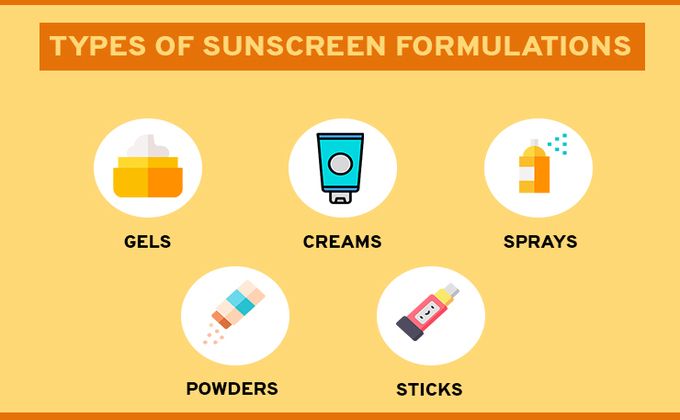How to choose a good Sunscreen for your skin
In Australia, skin cancer is the most common type of cancer, largely caused by exposure to ultraviolet radiation. To prevent skin related cancer, sunburn, and premature aging of the skin, sunscreen, which blocks UV rays, is widely recommended.
However, choosing the right sunscreen can be overwhelming, as there are many options available. Specifically, people often wonder which is the best sunscreen for their skin because of the debate between chemical and physical sunscreens.
In order to determine which sunscreen is right for you, let’s examine the differences between these two types of sunscreen.
How sunscreen contributes to skin cancer prevention
Sunscreens function by absorbing or reflecting UV rays, protecting the skin from damage. They contain chemicals that absorb UV rays and convert them into heat, or minerals that reflect and scatter UV rays.
There are two types of UV radiation that cause skin damage:
UV-A radiation causes long-term damage like premature ageing and wrinkles.
UV-B radiation is the most common cause of sunburn and contributes to skin cancers, including melanoma.
So, it is highly recommended to use sunscreen formulated to block both UVA and UVB rays. The term “broad spectrum” is often used to describe them.
Which is better, physical or chemical sunscreen?
In general, sunscreens can be categorized into two main types:
1. Chemical Sunscreens:
Chemical sunscreens are composed of organic compounds that absorb UV radiation and convert it into heat, which is then released from the skin. Chemical sunscreen ingredients include avobenzone, oxybenzone, octinoxate, and octocrylene. These sunscreens are formulated for various skin types (normal to combination, oily and acne-prone, dry) and offer water-resistant protection.
Features of chemical sunscreens are:
Apply 20 minutes before sun exposure.
Reapply every 2 hours and after swimming or sweating
Generally less visible on the skin, lighter, and less greasy for daily comfort.
they are more water-resistant
Concerns about chemical sunscreens:
Some ingredients, like oxybenzone, may harm coral reefs and marine life when washed off.
Potential for skin irritation or allergies in sensitive individuals.
2. Physical Sunscreens:
Physical sunscreens, also known as mineral sunscreens, contain inorganic compounds such as zinc oxide and titanium dioxide. These minerals create a protective barrier on the skin’s surface, reflecting and scattering UV radiation away from the skin.
The advantages of physical sunscreens include:
Protect the skin immediately upon application.
Less likely to cause skin irritation, making them suitable for sensitive skin types.
Generally considered environmentally friendly.
And concerns about chemical sunscreens:
Heavier texture than chemical sunscreens.
May leave a visible white cast on the skin
Thicker formulations may not be ideal for oily or acne-prone skin.
Choosing the right sunscreen involves considering individual skin needs and preferences. It is recommended that you choose a water-resistant option with broad-spectrum protection and an SPF of at least 30.
Do you need a specific formulation of sunscreen?
Sunscreens come in various formulations to cater to different preferences and skin types. Some of the most common are listed below:
Lotions and Creams: Ideal for dry skin and regular use. They provide thorough coverage but can be heavy and greasy.
Gels: Suitable for oily or acne-prone skin. They are lightweight and non-greasy.
Sprays: Convenient for application to large areas and hard-to-reach places. However, even coverage can be challenging.
Sticks: Perfect for targeted areas like the face, ears, and shoulders. They are less messy and easy to carry.
Powders: Suitable for reapplying over makeup. They are lightweight and matte.
On the whole, applying sunscreen tailored to your skin type simplifies your skincare routine while providing maximum protection and benefits for your skin.
Selecting the right sunscreen involves considering various factors, including skin type, activity level, and personal preferences. You can choose the appropriate type and formulation by following these tips:
Sensitive skin: use physical sunscreens with zinc oxide or titanium dioxide. These ingredients are less likely to cause irritation.
Oily or Acne-Prone Skin: Choose oil-free, non-comedogenic formulas in gel or spray forms.
Dry Skin: Look for moisturizer-type sunscreens.
Active Lifestyles: Water-resistant sunscreens are essential for swimming or sweating.

How much sunscreen should be applied to achieve the SPF protection mentioned on the product's label?
Even when sunscreen is applied, many people do not use enough sunscreen, resulting in sunburns and tanning. In order to obtain the SPF protection labeled on a sunscreen bottle you should use about two milligrams of sunscreen per square centimeter of skin.
Practically, applying sunscreen to exposed parts of the body and face requires two tablespoons (a shot glass) of sunscreen.
Make sure to apply sunscreen 15-30 minutes before heading outside.
Remember to reapply every two hours, or after swimming or sweating.
Do not forget to apply sunscreen under your makeup and other skincare products as well.
Common Myths about Sunscreen
There are several myths about sunscreen you may be confused about. Here are some misconceptions to clear up:
Time of Day: UV rays are strongest between 10 a.m. and 4 p.m., but you still need protection throughout the day.
Cloudy Days: Up to 90% of UV rays penetrate clouds, so sunscreen is necessary even on overcast days.
Dark Skin: Dark skin tones are also at risk of sun damage, including wrinkles and dark spots.
Makeup with SPF: Makeup with SPF offers some protection, but it’s not enough. Apply sunscreen underneath for full coverage.
Vitamin D: Sunscreen allows enough UVB rays for vitamin D synthesis; dietary sources are a safer option.
SPF Levels: SPF 30 blocks 97% of UV rays; higher SPFs offer minimal additional protection and require frequent reapplication.
Types of Sunscreen: Physical (mineral) and chemical sunscreens differ in how they protect; choose based on your skin type and preference.
Sunscreen Expiration: Check expiration dates as sunscreen loses effectiveness over time
In conclusion, sunscreen is an excellent tool for preventing skin cancer. It is possible to significantly reduce your risk of skin damage and skin cancer by understanding the different types of sunscreens, their formulations, and how to use them correctly. Remember, consistent and proper sunscreen use, along with other sun protection measures, is key to maintaining healthy skin and preventing skin cancer.


